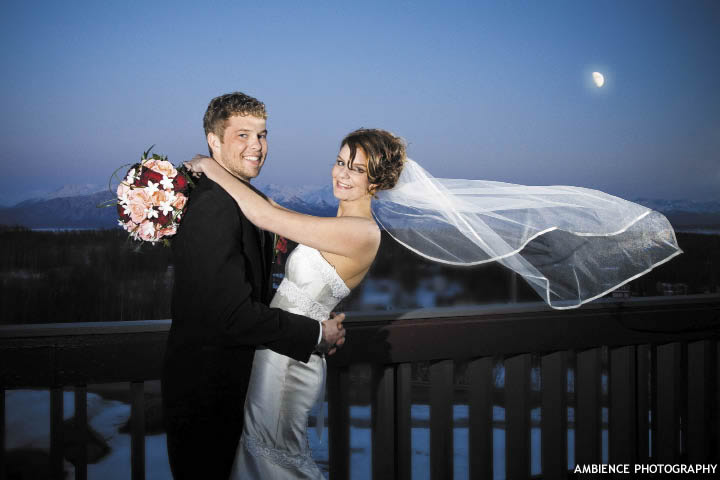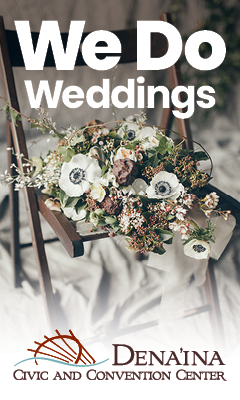
Photography Mythology
Demystifying the myths surrounding professional wedding photography
By Mara Severin
Your wedding photographer may be the first and only photographer you ever hire, so the prospect can be daunting. We’ve consulted with Alaska’s top photographers to help demystify the process. You might want mystery in a beautiful wedding photograph, but you don’t want it when you’re hiring a wedding photographer.
MYTH NUMBER 1
Make an exhaustive list of essential shots
“A lot of these lists are basic things,” says Carl Johnson of Carl Johnson Photography. Exchanging rings, the first kiss, cutting the cake are all examples of shots specified by nervous couples. “If a photographer doesn’t know enough to photograph these things, then you shouldn’t hire him,” he says.
Lori Zervantian of Farrar Photography agrees, adding, “A good photographer is going to try to get everything they can, but they are not going to promise you that they can get everything.” This is your wedding, says Zervantian, not a photo shoot. “If there’s a photographer jumping around on the altar,” she says, “that’s what your guests will remember.”
“I wish you could publish a few of the lists I’ve gotten,” says Joe Connolly of Chugach Peaks Photography. He keeps the elaborate ones as examples for his clients of what NOT to do. “I say, ‘Look at this, tell me if you understand it, and tell me if you think this went efficiently on the day of the wedding.’”
MYTH NUMBER 2
Bad weather is a photographic washout
In Alaska, the only thing predictable about the weather is its unpredictability. But a little rain doesn’t mean your photographs will be a washout. Alaska’s best photographers have the equipment, the experience, and the creativity to make your pictures shine, even when the sun doesn’t.
First of all, says Zervantian, even a really rainy day takes a break now and again. So be patient, enjoy the reception, and then sneak out when you can. Plus, she says, from a photographer’s point of view, “cloudy weather is more optimal than sunny because it provides more even lighting.”
And there are “ways to cheat,” says Zervantian. She took “outdoor” shots of a couple beneath a church awning with a backdrop of trees. Basically, she was inside shooting out. “You wouldn’t know they weren’t outside,” she says. This picture was so successful; she uses it in her sample album.
Or she says, be playful and creative. “Do something fun with umbrellas,” she suggests. “Some of the most beautiful work I’ve seen was a shot in the rain,” Zervantian says. “He’s pulling her veil over himself and they’re kissing. They’re alone in the moment… There’s a sense of intimacy.”
“Embrace the weather,” agrees Connolly. “You can do cool things in it.” He recalls a “completely foggy” wedding he shot on the Hillside. He photographed the couple in the woods and the resulting photographs were atmospheric and romantic.
MYTH NUMBER 3
Professional photographers charge too much
Sometimes, the same people who choose the lobster buffet, the exclusive designer gown and the best bubbly will balk at a professional photographer’s estimate.
It’s a misunderstood industry, agree our experts.
“People don’t realize the work involved that’s not actually out in the field,” says Johnson. An 8- to 10-hour day of shooting can result in 20 to 40 hours of processing and editing, he says. And professional lighting and color correction can be the difference between photographs carefully cherished in an album and the ones slapped on your fridge with a magnet.
And then there’s the equipment. “My camera gear is worth more than my car,” says Connolly, “and it has to be replenished and replaced every few years.”
And remember that you’re hiring an artist. “You’re not buying tires here,” says Connolly. “You can’t just call up eight different places with a model number and choose the one that’s $12 cheaper.”
In fact, says Zervantian, “If the photographer’s too cheap, that’s kind of scary.” You might be getting a hobbyist, or a “weekend warrior,” she says, who doesn’t have the kind of training and experience you’re looking for.
MYTH NUMBER 4
You need to choose between a formal photographer and a photojournalist
Photography styles change – that’s no myth, says Zervantian. But that doesn’t mean that you’re at the mercy of whatever trends are in on the day of your wedding. “Back in the 70s and 80s things were more formal,” she says. Then there was a radical shift to natural, more spontaneous photography. “Now,” she says, “there’s a movement toward blending styles. Most photographers know that both are valid and important.”
All good photographers should have a streamlined and efficient way of shooting the wedding party. But a photographer should also be able to help you capture the uniqueness of the day and of your relationship. Artistic, editorial and spontaneous shots can be taken even if you’re not that comfortable in front of a camera. Says Connolly: “I’m not going to try and create something that isn’t reality.” But an experienced photographer can find the moments that you’ll cherish most when you look back.
“You want a photographer who reflects your personality,” says Johnson. “You want to have pictures that you’re going to be happy looking at for the rest of your life.”
MYTH NUMBER 5
Aunt Jessica can do it!
“Having a friend or family member take your pictures is a bad idea on so many levels,” says Johnson. If your budget is really constrained, he suggests cutting costs, but not expertise. “Your photographer is going to archive the photos,” he says, “so you can wait on getting re-prints. Get some basic ones up front, and then wait for your PFD to order the rest,” he suggests.
Zervantian agrees that hiring anyone other than a professional can be a big mistake. “There’s no substitution for practice, practice, practice.” Your uncle might have a good camera, she says, but he’s not going to get the shots that a professional will. “Our livelihood depends on our images looking far more professional than your uncle’s,” she says.
Connolly agrees: “Even if I have the best brain surgery equipment, I still don’t know how to do brain surgery.”








